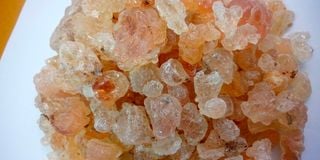Asals’ future lies in Gum Arabic tree farming

Gum Arabic collected from acacia tree.
What you need to know:
- Gum Arabic habitat faces unsustainable terrestrial ecosystem challenges and biodiversity loss.
- This is the appropriate time for a paradigm shift to commercial agroforestry of Gum Arabic trees.
Taming plants for human survival has been part of human history. This has led to plantations and industrial development.
We propose commercial domestication and development of remote indigenous Gum Arabic trees of the Arid and Semi Arid Lands (Asal) to plantation agriculture and growth of related industries.
The advantage is that these regions have large tracts and the plants naturally occur in the local biodiverse vegetations.
The plants include Commiphora myrrha (Malmal), Commphora holtziana ssp (Hagar), Acacia Senegal (Cadaad), Acacia siyal (fulai) and Boswellia neglecta (Mudufur/mirafur).
Gum Arabic plants are valued for their dried gum and resin from their stems and branches. The products are harvested during droughts for sale, as fodder or food.
This is in addition to wider industrial uses in pharmaceutical, perfume and soft drinks industries.
Contrary to the spirit of Goal 15 of the UN 2030 Sustainable Development Goals, Gum Arabic habitat faces unsustainable terrestrial ecosystem challenges and biodiversity loss from global warming, land degradation, inappropriate harvesting, growth of urban centres and frequent droughts. This is the appropriate time for a paradigm shift to commercial agroforestry of Gum Arabic trees.
Beneficial indigenous plants
They need to be propagated in Asal counties under sustainable reforesting, rewilding and plantation agriculture. It is a sure climate change investment to protect the environment and compliment other desert bush back efforts.
Trials in the Wajir County have established that these plants can be propagated through vegetative cut techniques and seeds. The cuttings can be planted just before the rains.
They grow naturally. The Sahel countries lead the annual global export trade of gum and resin at $1.5 billion, with Kenya’s Asal regions exporting $11 million. A kilo of Gum Arabic and resins is Sh700 to Sh1,500. A factory for value-addition has since been built in Wajir.
Afforestation plans in the dry counties used to be haphazard, with locals growing exotic and beautification plants targeting urban residents. Most were of little or no economic value and at best invasive and destructive to the environment.
These include Prosopis juliflora (mathenge) and the heavy water consumer Azadirachta indica (Neem tree) valued for its shade at the expense of other indigenous and Gum Arabic plants with commercial value and canopy. Investments in the Gum Arabic industry points to sustainable green economic opportunities and healthy biodiversity and ecosystems.
Policy and climate finance programmes should change towards Gum Arabic farming and other beneficial indigenous plants like sisal. This is the frontier that will enhance livelihoods and help reduce dependency on livestock – the economic pillar in Asal counties.
Khamis is a former Kenyan diplomat and currently,Chief Officer for Energy, Natural Resources and Forests, Wajir County. [email protected]




